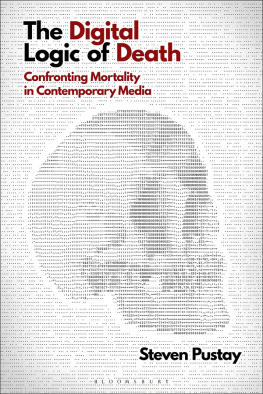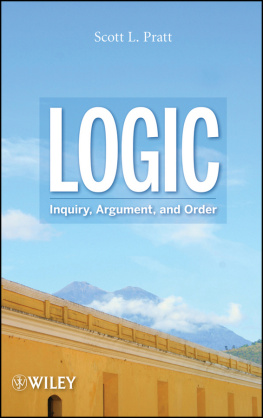This project would not have been possible without the support of a large group of people, many of whom were probably unaware of how much their interest and concern encouraged me during the difficult and long process of writing. First and foremost, I want to thank my committee at Georgia State University. My advisor, Angelo Restivo, not only guided this project, but also inspired a young grad student to look upon the world with a critical eye and a passion for nuance. Likewise, Alessandra Raengo has long been a constant supporter and friend, helping me to grow as a scholar and as a person. I may not have ever been a student in Jennifer Barkers classroom, but even our most casual conversations have had a profound impact on my scholarship and my approach to media. Greg Smiths straightforward and honest writing style has long been something Ive attempted to imitate, and it was Ian Bogosts work that first turned me on to reading popular media through the lens of critical theory.
Equally important were the friendship and support of my cohort at Georgia State Drew Ayers, Karen Petruska, and Kris Cannon whom Ive long relied upon for advice and empathy, and whom I will always greatly admire. Likewise, the encouragement of my colleagues Justin, Collin, Darcey, and Sam helped to spurn this project forward even when it was barely more than an idea. Thanks also to my many great friends, including Adam, Ryan, Barry, Traci, Ben, Joe, Bill, Pete, Steve, Casey, Jessica, Katie, Leslie, and Mandy, all of whom continually expressed interest in my work, and never once rolled their eyes or pretended to fall asleep as they listened to me describe this project for the thousandth time. Among them, a special shout-out to Kurt for his willingness to directly engage with my work, and to my sister Kelly and my brother-in-law Nick, who were always willing to listen and help.
Many thanks are also owed to my editor at Bloomsbury, Katie Gallof, whose support for this project brought a book about death back to life in more ways than one, and to her assistant, Erin Duffy, for her patience and editorial guidance. Elsewhere, my gratitude to Richard Pult for his assistance and support of this project on its journey toward publication, and to the team at Integra, especially Shanmathi Priya, for their diligent edits which helped the final book take form.Lastly, my biggest thanks to my mom, who once told me to just get it done and then continued to tell me the same thing over and over for the next three years (I love you mom!), and to my dad, who always agreed to listen to yet another revision, always thoughtfully engaged with my ideas no matter how strange or esoteric, and who has often been the only person I could count on to understand and alleviate my frustrations and my fears. Thank you.
One of the most profound yet critically overlooked consequences of the birth of the motion picture was that it, together with the rise of modern medical science, fundamentally uprooted our relationship with death. Indeed, ones understanding of mortality had long been grounded in a common though crucial act of looking, of bearing witness to the passing of loved ones and friends, of standing in the presence of death. Yet at the turn of the twentieth century, as the act of dying withdrew from the communal space of the home into the private space of the hospital, that ability to look suddenly and violently disappeared. No longer was it deemed necessary or even respectable to witness the passing of others, yet anxieties regarding death never waned and the desire to look upon its face never diminished. So the public turned to the moving image to satisfy their curiosity, and what followed was a century in which death was utterly abject yet intensely visible, the event itself increasingly hidden from everyday life even as its fictional representations became all the more frequent and all the more fetishized.
Despite the significant repercussions, this transition went largely unnoticed and unremarked. Instead, a perilous gap opened up between scholarly studies of death and those of popular media, preventing us from fully accounting for the role that moving images play in our understanding of mortality. On one side were the existentialists, thanatologists, and continental philosophers who gave rise to critically important questions regarding the influence of death upon our subjectivity, yet who so often failed to recognize how our collective cultural logic is shaped by our consumption of popular media. On the other were the film and media scholars who explored the impact of moving images on our experience of everyday life, without recognizing that those same images had entirely reconfigured our understanding of lifes inevitable conclusion. As we push further into a new digital age, it is essential that we begin to bridge this gap, especially given that our impression of death is once again shifting in response to new technologies of the image. This is the critical and urgent aim of this book, to not only unpack the nature of the relationship between death and the moving image, but also reveal how electronic media and digital technologies are transforming our ability to represent, contemplate, and confront the finiteness of the human experience, so much so that our contemporary media landscape has produced an entirely new understanding of mortality: a digital logic of death.
To confront the consequences of our mortality has been and forever will be a central philosophical concern of the human condition. Yet to study death to attempt to truly know death is an overly grand endeavor, overwhelming in its intense scope and magnitude, unsettling in its inconsistencies and implications. As a subject, death crosses all social and cultural boundaries, traversing the realms of philosophy, art, politics, science, religion; as an event, it remains painfully out of reach, visible to all yet objectively indefinable. To contemplate our mortality is to grapple with the ultimate contradiction, to glimpse the only event which is absolutely known (in its certainty) and absolutely unknowable (in its experience). Its for this very reason that death fascinates us, that we surround ourselves with its veiled presence. In our digital age, it seems impossible to watch a film, turn on a television, or play a game without being confronted by the image of death, at times indirectly or abstractly, but more often than not through an unabashedly direct representation.
While we know that the overwhelming majority of these images are pure fiction, we often fail to acknowledge that they reflect only a most basic understanding of the actual processes of death. In fact, our obsession with representations of death betrays a significant problem which lies at the heart of our contemporary relationship with mortality: despite the fact that we purposefully distance ourselves from the painful and uncomfortable realities of dying, we so often assume that we know death because we are inundated with its fictional image. To address this problem, this book takes as its subject not death itself, but rather our collective logic of death i.e., the culturally constructed characteristics and implications of the event of death and a privileged space in which this logic is continually formed and reformed: the moving image.
To speak of our logic of death is to refer not only to our understanding of what death is or the many forms that it can take, but also to the myriad and endless ways in which it affects our lives and culture. So much of our experience is informed by the notion that our time is fragile and finite, that the boundaries of our lives are frustratingly unknowable and yet painfully obvious. When we look ahead to our educations and careers and retirements, for example, we arrange our lives toward an end. When we write in our diaries, take photographs, or create social media posts, were structuring our legacies and leaving behind traces that we hope will outlast us. When we wear our seat belts, change our diets according to new science, or lock our front doors, we are acknowledging and protecting ourselves against the many ways in which death can come sooner than we would like. When we emphasize the importance of children, families, and societal structures, were recognizing that our own time on this planet is fixed and that others will endure after we are gone. In all of these ways and more, our lives are immeasurably shaped by our recognition of death.













